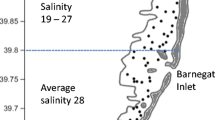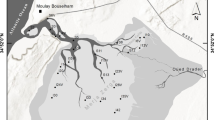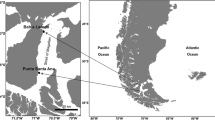Abstract
Temporal variations in composition and density of the benthic macrofauna at two stations (12 and 25 m depth) were studied in Admiralty Bay, King George Island, Antarctica. Samples where carried out using an van Veen sampler between March and December 1999 (winter) and December 2000 and March 2001 (summer), comprising a discontinuous annual cycle. Sediment organic matter showed a marked seasonal cycle, with lowest values at middle winter. Communities showed little variations in density and composition. Temporal variations were not detected at 25 m depth. Variations at 12 m were related to one iceberg impact and to wind generated hydrodinamism, as a function of wind direction, intensity and fetch. As winter scarcity of primary production did not seem to affect macrofaunal community densities, nutrient availability for the benthos in winter can be related to the remineralization of sediment organic matter by bacterial activity.







Similar content being viewed by others
Notes
Data provided by Dr. Alberto Setzer, INPE, Brazil
References
Arnaud PM (1985) Essai de synthese des particularites eco-biologiques (adaptations) des invertebres benthiques antarctiques. In: Mayzaud P (eds) Adaptations des etres marins aux eaux froides: aspects physiologiques et ecophysiologiques: seminaire anime par p. Mayzaud, Paris, pp 117–124, 6–13 Novembre 1984
Arnaud PM, Jazdzewski K, Presler P, Sicinski J (1986) Preliminary survey of benthic invertebrates collected by Polish Antarctic Expeditions in Admiralty Bay (King George Island, South Shetland Islands, Antarctica). Pol Polar Res 7(1–2):7–24
Arnaud PM, López CM, Olaso I, Ramil F, Ramos-Esplá AA, Ramos A (1998) Semi-quantitative study of macrobenthic fauna in the region of the South Shetland Islands and the Antarctic Peninsula. Polar Biol 19:160–166
Arntz WE, Brey T, Gallardo VA (1994) Antarctic zoobenthos. In: Ansell AD, Gibson RN, Barnes M (eds) Oceanography and marine biology: an annual review. UCL, London, pp 241–304
Battershill CN (1990) Temporal changes in antarctic marine benthic community structure. N Z Antarct Rec 10(1):23–27
Clarke A (1996) Marine benthic populations in Antarctica: patterns and processes. In: Foundations for ecological research West of the Antarctic Peninsula. Antarctic Research Series. American Geophysical Union, pp 373–388
Clarke A (1996b) Benthic marine habitats in Antarctica. In: Ross RM, Hofmann EE, Quetin LB (eds) Foundations for ecological research west of the Antarctic Peninsula. Antarctic research series. American Geophysical Union, pp 123–133
Engel J, Kvitek R (1998) Effects of otter trawling on a benthic community in Monterey Bay National Marine Sanctuary. Conserv Biol 12(6):1204
Gambi MC, Lorenti M, Russo GF, Scipione MB (1994) Benthic associations of the shallow hard bottoms off Terra Nova Bay, Ross Sea: Zonation, biomass and population structure. Antarct Sci 6(4):449–462
Gambi MC, Mazzella M, Lorenti M, Scipione MB (2000) Spatio-temporal variability in the structure of Benthic populations in a physically controlled system off Terra Nova Bay: the shallow hard bottoms. In: Faranda G, Ionora (eds) Ross Sea ecology. Springer, Berlin Heidelberg New York, pp 527–538
Grebmeier J, Barry J (1991) The influence of oceanographic processes on pelagic-benthic coupling in polar regions: a benthic perspective. J Mar Syst 2(3–4):495–518
Gutt J, Starmans A, Dieckmann G (1996) Impact of iceberg scouring on polar benthic habitats. Mar Ecol Prog Ser 137:311–316
Hair JFJ, Anderson RE, Tatham RL, Black WC (1998) Multivariate data analysis. Prentice Hall, Englewood Cliffs p 730
Kauffman TA (1977) Seasonal changes and disturbance in an antarctic benthic mud community. PhD Thesis, University of California
Lowry JK (1975) Soft Bottom Macrobenthic Community of Arthur Harbor, Antarctica. Antarct Res Ser 23(1):1–19
Mühlenhardt-Siegel U (1989) Quantitative investigations of Antarctic zoobenthos communities in winter (May/June) 1986 with special reference to the sediment structure. Arch FischWiss 39:123–141
Nedwell DB, Walker TR (1995) Sediment-water fluxes of nutrientes in an Antarctic coastal environment: Influence of bioturbation. Polar Biol 15(1):57–64
Nedwell D, Walker T, Ellis-Evans J, Clarke A (1993) Measurements of seasonal rates and annual budgets of organic carbon fluxes in an Antarctic coastal environment at Signy Island, South Orkney Islands, suggest a broad balance between production and decomposition. Appl Environ Microbiol 59(12):3989–3995
Oliver JS, Slattery PN (1985) Effects of crustacean predators on species composition and population structure of soft-bodied infauna from McMurdo Sound, Antarctica. Ophelia 24(3):155–175
Open University (1998) The ocean basins: their structure and evolution. Butterworth-Heneman, New York, p 258
Parulekar AH, Ansari ZA, Harkantra SN (1983) Benthic fauna of the Antarctic Ocean—quantitative aspects. Tech Publ Sci Rep FIEA 1:213–218
Peck L, Brockington S, Vanhove S, Beghyn M (1999) Community recovery following catastrophic iceberg impacts in a soft-sediment shallow-water site at Signy Island, Antarctica. Mar Ecol Progr Ser 186:1–8
Platt HM (1979) Ecology of King Edward Cove, South Georgia: macro- benthos and the benthic environment. Br Antarct Surv Bull 49:231–238
Retamal A, Quintana R, Neira F (1982) Analisis cuali y cuantitativo de las comunidades bentonicas en Bahia Foster (Isla Decepcion) (XXXV Expedición Antartica Chilena, enero 1981). INACH Serie Cientifica 29:5–15
Sokal RR, Rohlf FJ (1995) Biometry, The Principles and Practice of Statistics in Biological Research, 3rd edn. W.H. Freeman & Company, San Francisco, p 887
Stark JS, Snape I, Riddle JM (2003) The effects of petroleum hydrocarbon and heavy metal contamination of marine sediments of Antarctic soft-sediment assemblages: a field experimental investigation. J Exp Mar Biol Ecol 28:21–50
Thompson BW, Riddle MJ, Stark JS (2003) Cost-efficient methods for marine pollution monitoring at Casey Station, East Antarctica: the choice of sieve mesh-size and taxonomic resolution. Mar Poll Bull 46:232–243
Tucker M (1988) Temporal distribution and brooding behaviour of selected benthic species from the shallow marine waters off the Vestfold Hills, Antarctica. In: Ferris J, Burton H, Johnstone G, Bayly I (eds) Biology of the Vestfold Hills, Antarctica. Hydrobiologia, pp 151–159
Underwood AJ (1997) Experiments in ecology: their logical design and interpretation using analysis of variance, 1. Cambridge University Press, London, p 504
Wägele JW, Brito TAS (1990) Die sublitorale Fauna der maritimen Antarktis Erste Unterwasserbeobachtungen in der Admiralitaetsbucht. Nat Mus 120(9):269–281
Wägele JW, Schminke HK (1986) Leben in eisigen Tiefen: Benthosforschung in der Antarktis. Nat Mus 116(6):184–193
Wu B, Chen M, Wu Q, Huan F (1992a) A study on the quantity of shallow sea benthos in the Great Wall Bay, Antarctica. Antarct Res Nanji Yanjiu 4(4):55–61
Wu Q, Wu B, Chen M, Huan F (1992b) Community analysis of shallow sea benthos in the Great Wall Bay, Antarctica. Antarct Res Nanji Yanjiu 4(4):62–67
Zhang X, Lu P, Zhang K (1986) Population distribution of benthos and seasonal variation of biomass in the inshore water of Davis, Antarctica. In: Ed PL (eds) A collection of Antarctic Scientific Explorations 3. Chinese National Antarctic Research Expedition, China, pp 141–145
Acknowledgements
Authors wish to thank the CNPq-PROANTAR, SECIRM, and specially to the crew of the Brazilian Antarctic Station “Comandante Ferraz” for their crucial help in field work. We also wish to thank three anonymous reviewers for comments and criticism, and to Dr. Fernando Fernandez for reviewing the manuscript and for helpful comments.
Author information
Authors and Affiliations
Corresponding author
Rights and permissions
About this article
Cite this article
Echeverría, C.A., Paiva, P.C. Macrofaunal shallow benthic communities along a discontinuous annual cycle at Admiralty Bay, King George Island, Antarctica. Polar Biol 29, 263–269 (2006). https://doi.org/10.1007/s00300-005-0049-6
Received:
Revised:
Accepted:
Published:
Issue Date:
DOI: https://doi.org/10.1007/s00300-005-0049-6




